Sarah L. Johnson's Blog, page 28
January 6, 2022
The Last Rose of Shanghai by Weina Dai Randel, an epic love story set in Japanese-occupied Shanghai
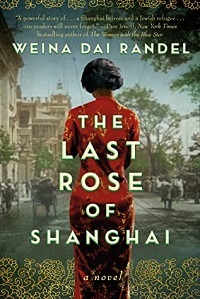 Set amid the maelstrom that was Japanese-occupied Shanghai beginning in 1940, Weina Dai Randel’s third novel is charged with incident and emotion matching its setting. It reads as if the author poured every ounce of creativity and feeling into her writing, and based on her comments at the end, this was the case.
Set amid the maelstrom that was Japanese-occupied Shanghai beginning in 1940, Weina Dai Randel’s third novel is charged with incident and emotion matching its setting. It reads as if the author poured every ounce of creativity and feeling into her writing, and based on her comments at the end, this was the case. At its essence, The Last Rose of Shanghai (named after the female lead’s favorite jazz song) tells the love story between Aiyi Shao, a young, sophisticated heiress who owns a nightclub called One Hundred Joys, and Ernest Reismann, the Jewish pianist she hires to attract new customers to her once-popular venue.
Ernest is newly arrived by ship from Nazi Germany with his younger sister, Miriam, and desperate for work after learning that Shanghai – the only port not requiring an entry visa – is flooded with other refugees. His foreignness is the problem, not specifically his religion; many Shanghainese, including Aiyi, are unaware of the antisemitism over in Europe. That remains true until it isn’t. When Japan forms an alliance with Germany, the Britons in Shanghai’s International Settlement become the enemy, and restrictions eventually tighten against the Jews.
The backgrounds of Aiyi and Ernest are gradually layered: she is reluctantly engaged to her conservative cousin, Cheng, yet despite her independent streak, she understands the importance of family. Ernest faithfully sends funds home for his parents to join him, not realizing until later that his efforts are futile (of course, the reader knows this). Their love affair is fiery and necessarily furtive. These passionate characters are flawed individuals who sometimes act out of selfishness, but with the world stacked against them in so many ways, it’s easy to root for their happiness.
The historical background comes alive with full-bodied color and sound, plenty of twists in the action, and brilliantly painted word-images: “… all of us Chinese in Shanghai were like trapped fish in a sunless marsh. To avoid the hook of death and go on living, we had no choice but to remain unseen under water,” Aiyi says. The author also weaves in cultural information, like the tones used to pronounce Aiyi’s name correctly (which Ernest never quite masters) and the bat mitzvah ceremony young Miriam prepares for. Anyone seeking an original focus on the frequently dramatized WWII era should pick up this book for a gripping emotional journey.
The Last Rose of Shanghai was published by Lake Union in 2021; I read it from NetGalley.
December 29, 2021
Isabel Allende's Violeta spans 100 years in a South American woman's amazing and eventful life
 Allende has crafted many unique heroines of passionate, resilient spirit in her internationally best-selling historical novels, and Violeta Del Valle is no exception.
Allende has crafted many unique heroines of passionate, resilient spirit in her internationally best-selling historical novels, and Violeta Del Valle is no exception. Born during the Spanish flu outbreak in an unnamed South American country (clearly based on Chile) in 1920, Violeta addresses her memoir to a beloved relative, Camilo, during the COVID-19 pandemic in 2020. She spins a captivating, cinematic tale of her century-long existence, intertwining large-scale political and social transformations with reflections on her life.
The spoiled daughter in a family with five older sons, Violeta watches the Del Valles’ finances tumble into ruin during the Depression. After losing their illustrious home, her family finds refuge in a remote southern farming town with many Indigenous residents and German and French immigrants.
This supposed exile becomes an enriching experience for Violeta. Her love life is complex, tumultuous, and unpredictable for readers, who will eagerly follow her narrative, which Violeta recounts in a style that’s remarkably forthright about her own and others’ personal failings.
The characterizations are intriguingly layered, and as people’s lives are buffeted by dramatic changes, including a military coup that destroys her country’s democracy, Violeta comes into her own strength. Allende has long been renowned as an enchanting storyteller, and this emotionally perceptive epic ranks among her best.
Violeta will be published by Ballantine in January; I reviewed it from a NetGalley copy for the 12/15 issue of Booklist (I made it a starred review).
There was no room to say this in the review, but past readers of Allende's work may recognize the name Del Valle, and Violeta is indeed connected to the characters from her first novel, The House of the Spirits. It's not a major part of this book, and you definitely don't need to read any others first, but the link is mentioned. Other Del Valle family members figure in Allende's Daughter of Fortune and Portrait in Sepia.
I'll be back after the New Year with more posts. Thanks for visiting my site, and best wishes for good reading for 2022!
December 21, 2021
Best-of-year historical fiction roundups from around the web
Now that 2021 is drawing to a close, media outlets have been publishing their "best of" lists from the past year. I've collected those that focus on historical fiction, though there aren't as many of these as I've found for other genres.
NPR's Best Books 2021 (which used to be called Book Concierge) has a historical fiction category with an impressively wide range of subjects and subgenres. I like how they include literary fiction (The Sweetness of Water), historical romance (Wild Rain), historical fantasy (A Marvellous Light), and books for younger readers (Finding Junie Kim) under the same umbrella. Among my own favorites on this list: Marie Benedict and Victoria Christopher Murray's The Personal Librarian and Laird Hunt's Zorrie.
The New York Times presents their best new historical fiction of the season with a dozen recent releases, as well as an overall "best of" for 2021. There's a bit of overlap between them. The focus is, as you'd expect, literary fiction, and I haven't read any of these!
In The Times (London) we have critics Nick Rennison's and Antonia Senior's 15 top favorites of the year. Without a subscription you'll need to sign up for a free login, which gets you access to a limited # of articles. There's a nice mix of literary and commercial here, including Elodie Harper's The Wolf Den (set in Pompeii before the infamous eruption of Mt. Vesuvius), which I also loved. It will be published in the US next March.
In Canada, the CBC has 12 books for the historical fiction lover's shopping list, which includes some novels set in very recent history.
British magazine Women and Home offers many historical novels (not all by women) for consideration for your TBR, conveniently divided by historical era.
Cosmopolitan has a lengthy list of 27 best historical novels from the last year. While it was posted in late October, some fall reads are included.
Lastly, Goodreads announced their most popular choices for Best Historical Fiction a few weeks ago, and I actually read nine of the nominees (but not the winner, Taylor Jenkins Reid's Malibu Rising).
December 15, 2021
In Protector, Conn Iggulden continues his saga of the Greco-Persian Wars with the heroic story of Themistocles
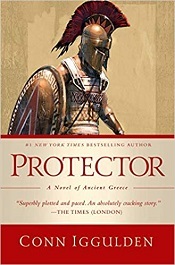 In 480 BCE, the Persians are back, more determined than ever to crush Athens. Picking up where The Gates of Athens ended, the story continues exploring how the Athenians and their Spartan allies come together, not without difficulty, to repulse Persian invasion forces on land and sea despite being vastly outnumbered.
In 480 BCE, the Persians are back, more determined than ever to crush Athens. Picking up where The Gates of Athens ended, the story continues exploring how the Athenians and their Spartan allies come together, not without difficulty, to repulse Persian invasion forces on land and sea despite being vastly outnumbered. Three major battles – first Salamis, then Plataea and Mycale the following year – are skillfully choreographed, giving readers an overarching picture of the many moving parts alongside firsthand perspectives of the military commanders. The starring role belongs to Themistocles, an Athenian statesman and general whose tactical genius is matched by pride in his own abilities, a flaw which irritates his fellow leaders.
Iggulden makes a persuasive case for recognizing Themistocles as Western civilization’s ultimate savior. Being inside this heroic character’s head as he strategizes is a breathtaking experience.
The dialogue feels realistic while offering a sense of the momentous through many quotable lines and stirring oratory, particularly from the politician Aristides. Devotees of the ancient world will relish this exciting historical novel.
Protector was published in November by Pegasus, and it was out in the UK in May from Michael Joseph. I wrote this review for Booklist's Oct. 1 issue. As with the previous book, The Gates of Athens , this series isn't just for military history fans (a group I don't consider myself part of), although the battle scenes really are sharply done. The characterizations are first-rate, and it was great to have the sense of being there while history was being shaped.
December 9, 2021
Review of Diane Gaston's holiday-themed Regency romance, Lord Grantwell's Christmas Wish
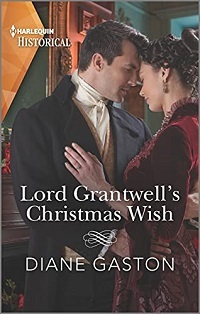 In her Regency romance featuring two estranged lovers, Gaston adds a dash of Christmas spice to a heartwarming story about the meaning of home and family.
In her Regency romance featuring two estranged lovers, Gaston adds a dash of Christmas spice to a heartwarming story about the meaning of home and family. When Lillian Pearson arrives at the palatial Yorkshire estate of Lord Grantwell in December 1817, she’s freezing, starving, and utterly frantic. Her Portuguese former brother-in-law is tailing her, convinced that she murdered her late husband.
Lillian knows she’s innocent, and she takes risks in asking Grant to hide her. They’d had a passionate affair years earlier, in Lisbon, until he caught her giving Wellington’s secret plans to the French—or so he believes. He’s never forgiven her.
Having recently become the guardian of his late brother’s orphaned stepchildren, Grant’s hands are full. But when he sees how well Lillian cares for young William and Anna, his heart starts softening.
The children are adorable, though traumatized from their earlier life; frustratingly, we don’t get the full backstory for their odd situation (they’d previously lived with their hard-hearted grandfather, not their mother and stepfather). Readers get to experience the joy of Regency-era Christmas traditions and children’s pastimes as Lillian and Grant try to give William and Anna a happy holiday, falling in love in the process.
Lord Grantwell's Christmas Wish is a Harlequin Historical title and the second in the author's Captains of Waterloo series, though it stands alone. I reviewed it initially for the Historical Novels Review last month. The first book, Her Gallant Captain at Waterloo, told the love story of Grant's estate manager and good friend Rhys Landon, a fellow soldier he'd met in Portugal, and the woman he married. Rhys and his wife are major secondary characters in this volume. This romance has impressive depth for a novel of just over 200 pages.
December 6, 2021
Interview with Jeri Westerson about The Deadliest Sin and wrapping up her Crispin Guest medieval mystery series
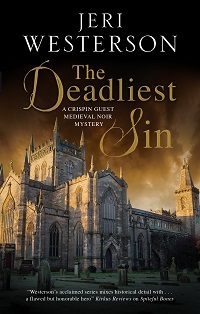 With her appearances on this blog during the publication of her Crispin Guest medieval mystery series, Jeri Westerson is coming full circle. Back in 2008, I'd published her guest post about Veil of Lies, in which Crispin made his first appearance in print, and this week the 15th and final book, The Deadliest Sin, will appear from Severn House. I've also reviewed a couple of the books here, including
Cup of Blood
(the prequel) and
The Deepest Grave
(book 11). So including an interview with the author for this series finale seemed like a neat idea.
With her appearances on this blog during the publication of her Crispin Guest medieval mystery series, Jeri Westerson is coming full circle. Back in 2008, I'd published her guest post about Veil of Lies, in which Crispin made his first appearance in print, and this week the 15th and final book, The Deadliest Sin, will appear from Severn House. I've also reviewed a couple of the books here, including
Cup of Blood
(the prequel) and
The Deepest Grave
(book 11). So including an interview with the author for this series finale seemed like a neat idea.To briefly recap for newcomers: Crispin Guest is a disgraced knight turned detective on the streets of late 14th-century London. He had lost his noble title and fortune after joining with others to place his mentor John of Gaunt, Duke of Lancaster, on the throne, thus committing treason against King Richard II. Over time, Crispin's successful pursuit of justice under the nickname "the Tracker" has gained him a certain level of renown.
In The Deadliest Sin, opening in 1399, Crispin is asked by the prioress of St. Frideswide's to investigate the deaths of nuns whose murders depict two of the Seven Deadly Sins. At the same time, the political scene is heating up: Henry Bolingbroke, his late mentor's son, is returning from exile abroad and aiming to secure his inheritance.
So, there's a lot that The Deadliest Sin needs to do: solve a complicated murder mystery, present the historical backdrop and engage with Crispin as he decides whether to side with King Richard or Bolingbroke, and wrap up the whole series. It accomplishes all three of these goals superbly. Plus, we get to see a new side to Jack Tucker, Crispin's apprentice, and his former lover Philippa also plays a role. While I'm sorry to say goodbye to Crispin, Jack, and company, the series ends on a terrific note. If you wanted, you could start with this book, since each novel is self-contained, and the necessary backstory is laid out in the beginning of each.
Hope you'll enjoy this Q&A, and thanks to Jeri for answering my questions!

The Deadliest Sin takes place in 1399, which followers of English history will recognize as a turning point for the country. This created a lot of anticipation as I guessed how that would affect Crispin and his loyalties. You’ve written that you’d known from the beginning that the series would wrap up at this time. That said, did any elements about the storyline (or series as a whole) play out differently than planned when you sat down to write it?
Well, I didn't have any idea what the mystery would be in the last book. That had to come in its time. And with all that had come before in Crispin's life. I had planned his lady love from the beginning, too, but not other details. As for the series as a whole, I hadn't intended Jack as a continuing character, but when my editor asked if he'd be in the next book because readers liked him so well, I was all on board. And serendipitous it was, because Jack stood in for the reader, asking the questions readers wanted to know about the plot, and being the person in Crispin's life who was able to change him for the better, just by his presence. After all, when Crispin reluctantly took in this street urchin and cutpurse (Jack was eleven at the beginning), Crispin had no idea he'd have to raise the boy; teach him to read and write, and begin to look upon him like a son rather than a servant, as close as they had become.
In some ways, St. Frideswide Priory is an unusual and pretty disturbing place for a community of nuns. How did you come up with the setting and the crimes committed there?
Cloistered life is always fodder for disturbing stories, especially for nuns, many of whom had had no desire to be there but were forced by parents because of circumstances; not being able to marry them off, etc. Some of these places were the making of these women, while others were dark and unwholesome places. The women only learned the rudiments of the prayers, some having no skills with Latin with no time to really teach them except for what they needed to know to get by. It seemed a natural place for crimes. And the Seven Deadly Sins...a no-brainer. But really...what is the deadliest sin? Probably not what you think.
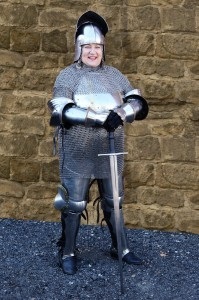 You’ve clearly accumulated a vast array of knowledge about daily life and politics in 14th-century England. What new research, if any, did you have to undertake to write this last volume?
You’ve clearly accumulated a vast array of knowledge about daily life and politics in 14th-century England. What new research, if any, did you have to undertake to write this last volume? There's always something I need to concentrate on for each volume, whether it's the relics or biographies of the real people, and this one I certainly had to get right about both Richard and Henry. Richard had gone to fight in Ireland and later met up with a chronicler poet from France who was an unwitting witness to his downfall. And Henry amassed an army and didn't really meet any opposition when he decided to make for England from his exile in France. It was all very interesting. Originally, I had begun the book in chapters alternating between Richard's venture and Henry's across England as he returned to take back his lands and title and then start the mystery, but the powers that be didn't want that. I still think readers would have easily immersed in it, but... *shrug* All in all, I can see that point of view because though there is an arc of the characters' lives running through the series, each book can technically stand alone, and this could have confused new readers.
Aside from perhaps Jack Tucker, do you have a favorite secondary character (or characters) from the series?
Absolutely. I really got to like John Rykener, a real person from the late fourteenth century. We know about him from one document of his arrest. He was a cross-dressing male prostitute and serviced both men and women. He was arrested not for prostitution, but for dressing as a woman. A big no-no. When he wasn't plying his trade, he served as an embroideress. And really looking deeply at him between the lines of the document, it's possible he is an example of a trans person in a time when such a notion was entirely foreign. Of course, so was homosexuality. He did say in the document when he was embroiled in an altercation with another man about a gown, that he would sic his "husband" on the man. And it was only later that I decided he would get his husband in the person of my fictional lawyer Nigellus Cobmartin, one of my favorite names for a character. They got their own story in Spiteful Bones, the penultimate book in the series.
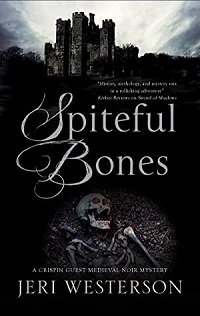
Different religious relics are another element linking the series together, and it’s always interesting to see how they’ll appear within the books. How did this idea originate?
I was originally writing historical fiction stand alones, with ordinary people in extraordinary circumstances. But these were not the kinds of books publishers wanted to publish. They wanted recognizable characters in the courts and I just felt that was done to death. A former agent of mine suggested I write medieval mysteries, and it seemed that this kind of conceit worked better as a mystery, with fictional characters killing fictional victims amid the backdrop of real people of the time period. So I had to learn to write a mystery. And I didn't want your Brother Cadfael or nuns investigating, I wanted a man who had been set adrift from all that he had known, a knight who was banished from court and had lost it all. A hardboiled detective in a medieval setting, so I turned to one of my favorite books, The Maltese Falcon, and literally tore the book apart to see what made it tick; beat by beat, climax by climax, paragraph by paragraph. And during all that research, I really liked the idea of the falcon, the McGuffin that propels the plot and has with it its own mystique. In the fourteenth century, that translated to religious relics or venerated objects. They added a little something extra. It could be the center of the action, or something tangential, or even a red herring. We've had all sorts of things: the Crown of Thorns, the Virgin's Tears, Christ's blood, and even the Philosopher's Stone and Excalibur.
Over the fifteen books, the series has moved from Minotaur to Severn House with a dip into self-publishing for the prequel, Cup of Blood, and it’s great to see how well Crispin has survived today’s complicated publishing climate. What are some takeaways you’ve learned about the industry, given your experience?
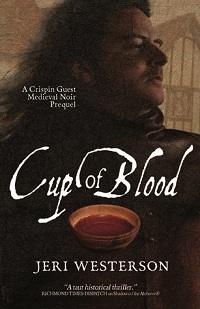 Yes, and I was lucky to be at that juncture when all was changing. After all, once upon a time when a big publisher dropped a series, that was it! It was done. But my agent felt there was still some life yet in it and I was definitely not done writing it. I knew it would take some time for him to find another publisher, so I picked up the real first book in the series that St. Martin's rejected--Cup of Blood--dusted it off, rewrote a lot of it, got it edited, and self-published it as a "prequel." My agent, of course, didn't want me to do that since he would have no stake in it, but it garnered two mystery award nominations and it had the added bonus of not letting a year go by without a Crispin book on the shelves. I always liked that story anyway, and it is where Crispin encounters Jack for the first time. So I'm certainly glad I did it. It got a boost because it belonged to an already established series, and I marketed heavily to libraries and knew it would still have the imprimatur of St. Martin's still attached to it. It's always done well and continues to do well. I can't necessarily say that for some of the others I have self-published, though they are in a different genre, that of paranormal.
Yes, and I was lucky to be at that juncture when all was changing. After all, once upon a time when a big publisher dropped a series, that was it! It was done. But my agent felt there was still some life yet in it and I was definitely not done writing it. I knew it would take some time for him to find another publisher, so I picked up the real first book in the series that St. Martin's rejected--Cup of Blood--dusted it off, rewrote a lot of it, got it edited, and self-published it as a "prequel." My agent, of course, didn't want me to do that since he would have no stake in it, but it garnered two mystery award nominations and it had the added bonus of not letting a year go by without a Crispin book on the shelves. I always liked that story anyway, and it is where Crispin encounters Jack for the first time. So I'm certainly glad I did it. It got a boost because it belonged to an already established series, and I marketed heavily to libraries and knew it would still have the imprimatur of St. Martin's still attached to it. It's always done well and continues to do well. I can't necessarily say that for some of the others I have self-published, though they are in a different genre, that of paranormal. Now that Crispin’s investigations have come to an end, at least on paper, what’s next for you in historical mysteries or historical fiction in general?
Well, I had just finished my gaslamp-steampunk fantasy series, the Enchanter Chronicles Trilogy, with the last book just released called Library of the Damned. That got me into researching the Victorian era (yes, even though it's fantasy, the era must be researched to give readers a foundation while they navigate all the paranormal things that are going on.) And so I didn't want to waste all that research and I got to thinking about a new Sherlock Holmes pastiche with one of his Baker Street Irregulars--all grown up--who starts his own consulting detective agency, with Holmes being one step ahead of him, and my detective trying to keep a step ahead of the law. It's a humorous mystery series where Holmes makes his appearance every now and then.
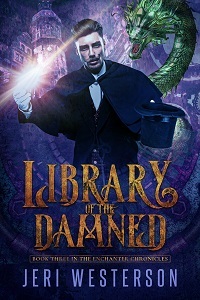
And then there is a Tudor mystery series that has been percolating a while in my head, and I finally completed the first in that series, Courting Dragons. Will Somers, Henry VIII's real court jester is the amateur sleuth. This also has a lot of humor, being in the pov of a court jester, and we see Henry through Will's eyes. It's called the King's Fool Mysteries and I hope my agent can sell it next year and to see the first published by the end of 2022 or in 2023. So I think I'll be busy for a bit.
Thank you for hosting me here. I appreciate the opportunity to talk about my Crispin series and upcoming series.
December 1, 2021
Zenobia Neil's Ariadne Unraveled: A Mythic Retelling presents a new side of the classical Greek myth
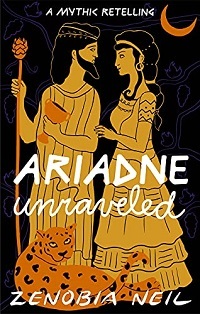 Best known in Greek mythology as the Princess of Crete who helped the Athenian prince Theseus escape the labyrinth and kill the Minotaur, her half-brother, Ariadne is given fresh treatment in this new retelling.
Best known in Greek mythology as the Princess of Crete who helped the Athenian prince Theseus escape the labyrinth and kill the Minotaur, her half-brother, Ariadne is given fresh treatment in this new retelling. The prologue impressively evokes her despair and fury after waking alone on the shores of Naxos, abandoned by Theseus, her lover, after betraying her family for him. Neil first moves back and then forward from this low point in Ariadne’s life, giving her agency and showing her as much more than a selfish man’s discarded mistress.
Ariadne Unraveled primarily recounts the romance between Ariadne and her husband Dionysus, the god of wine and ecstasy, among other fun qualities, and how their life together is thwarted by the capricious jealousy of the goddess Artemis, Dionysus’s half-sister, whom Ariadne serves. (Theseus comes back into the picture midway through.)
Many different versions of Ariadne’s story exist, and Neil stitches a collection of them together into a coherent whole, all written in bright and energetic prose. Alongside their love story, we witness the ebb and flow of power: how Ariadne, a high priestess used to being surrounded by eager handmaidens, contends with the gradual loss of hers, while Dionysus, a new god, learns to control his divine abilities.
The writing style is anything but dry. The Minoans are an attractive, athletic, and sensual people, and the varied sex scenes will definitely steam up your Kindle. The special effects are fabulous, too: we have creative shapeshifting, wild drunken parties, gods making trouble, and grapevines that magically twine around things.
In contrast, the author’s portrait of the underworld is hauntingly plaintive. While Dionysus and Ariadne seem to fall in love instantaneously, their relationship grows in emotional richness over time. In all, an entertaining reinterpretation of a classic story.
Ariadne Unraveled was published in July by Hypatia Books, and I'd reviewed it from my own copy for November's Historical Novels Review. As you can infer, this was a fun book to read, and a fun review to write. Ariadne's story has been a favorite of mine for a long time, ever since reading June Rachuy Brindel's novel Ariadne (1980) when I was in high school. I've also used it as a nickname on various online bulletin boards for years, including on LibraryThing. So of course I was going to read this novel eventually. I haven't yet read Jennifer Saint's Ariadne. Historical fiction readers who enjoy Greek myth retellings now have a lot to choose from!
November 26, 2021
Some beautiful historical novel cover designs
I recently ordered a copy of Alison Weir's latest book, In the Shadow of Queens, from Book Depository. It's a collection that reprints the e-shorts (digital-only short stories and novellas) the author wrote to accompany her Six Tudor Queens books, a series of full-length historical novels about Henry VIII's wives. The e-shorts, which reveal little-known accounts taking place in the shadow of larger events from Tudor history, were only sold in UK outlets, so I, as an American reader, wasn't able to buy them until now. Even then I had to buy a copy from overseas, since the book isn't being released in the US. There are 13 tales in the collection.
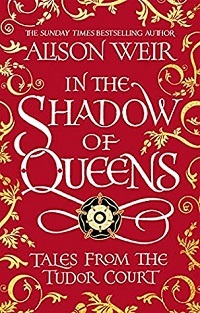
It's not apparent from the image above, but the book doesn't have a dust jacket. Instead, the design is printed directly on the cloth, and it's an absolutely gorgeous package.
Then I got to thinking about whether I owned any other examples like this, and found only a few on my shelves... not many at all. It seems more common for genres like cookbooks, reference books, and picture books than for historical fiction (aside from graphic novels).
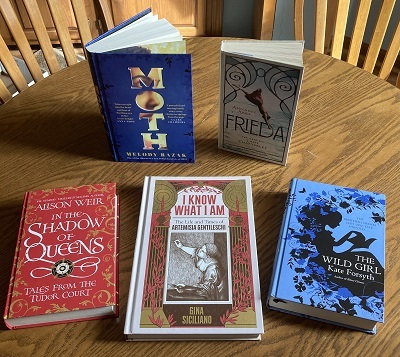
All but one of these above, the graphic novel/biography about Italian Baroque painter Artemisia Gentileschi at the center, was published by a British publisher. Moth by Melody Razak, at top left, a new release set during the Partition of India, has an elaborate cut-out design and a stepback cover featuring a woman's face.
Below are two other examples, older historical novels from American publishers.
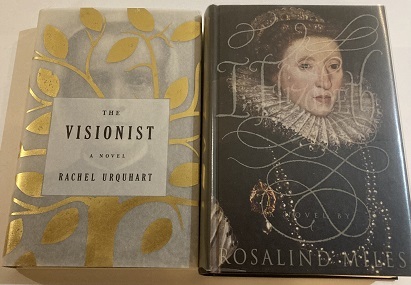
Both of these feature art printed directly on the cloth and a near-transparent dust jacket with the title, author, and other elegant design elements.
These beautiful designs represent a significant investment from their publishers. Can you think of any others like this? I don't live within easy reach of print-and-mortar bookstores (other than Walmart and a few used bookstores downtown) so do almost all of my book shopping online, but if I saw any of these books on display, I'd be tempted to buy them for the covers alone!
November 21, 2021
Eleanor Kuhns' Murder on Principle unravels a mystery in early 19th-century Maine
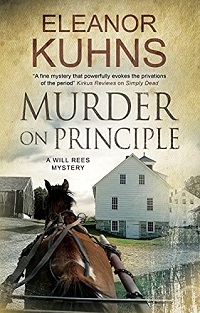 A man garbed in a bright yellow waistcoat, fawn-colored pantaloons, and red-trimmed Hessian boots is an unusual sight in the Maine woods, and the state of his body is even more so. The fashionable Mr. Randolph Gilbert lies dead, both strangled and stabbed.
A man garbed in a bright yellow waistcoat, fawn-colored pantaloons, and red-trimmed Hessian boots is an unusual sight in the Maine woods, and the state of his body is even more so. The fashionable Mr. Randolph Gilbert lies dead, both strangled and stabbed. In November 1800, Will Rees, weaver and amateur detective, is asked by Constable Rouge, his sometime rival, to help solve the murder, which was discovered by an elder from the nearby Shaker community. After Rees learns Mr. Gilbert’s purpose in town, he grows nervous. The man was seeking to recapture a light-skinned young woman and her baby who fled enslavement in Virginia, and Rees and his wife, Lydia, have just returned from that state on an abolitionist mission (as recounted in Death in the Great Dismal, the previous book).
The theme explored in this sharply rendered historical mystery, tenth in series, is a powerful moral question. “If the victim is a slave catcher, well then, I say thank you to his murderer,” Rees’s friend Tobias, a free man of color, tells him, requesting that he drop the investigation. Rees’s natural inclination to pursue justice causes him internal conflict, and his Black friends may not forgive him if he succeeds. Plus, he can’t help but wonder if they themselves are guilty.
Kuhns devotes close attention to fine period details, from cooking implements to rural Shaker lifeways, while the contemporary relevance of some plot aspects is unmistakable. The late Mr. Gilbert was ill with smallpox, the pestilence is quickly spreading, and Rees moves to quickly inoculate his children using a doctor’s suggested methodology. Not everyone puts their trust in science, though.
The novel stands alone, though some characters’ backstories (the origin of Rees’s large, blended family, for instance) aren’t immediately obvious to newcomers. Recommended for readers enamored of early American settings.
Murder on Principle was published in 2021 by Severn House, and I'd reviewed it from NetGalley for November's Historical Novels Review. The first book in the series is A Simple Murder, which won the Minotaur Books/Mystery Writers of America First Crime Novel competition in 2011. This latest book is the 10th in the series. The author, a fellow librarian, is the Assistant Director of the Goshen Public Library in upstate New York.
November 12, 2021
Housekeeper Mrs. Jeffries and her team solve another crime in Emily Brightwell's holiday-themed Victorian mystery
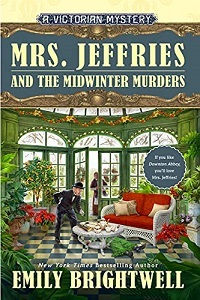 In Victorian London, Inspector Gerald Witherspoon of the Metropolitan Police Force has a reputation to uphold as a crackerjack crime-solver. But there’s a secret: he has help, and he’s unaware of it. Whenever he gets a new homicide case, his intrepid housekeeper, Mrs. Jeffries, calls meetings with her fellow servants and supportive neighbors, and they put their heads together. After Witherspoon comes home each evening, he relaxes over a glass of sherry with Mrs. Jeffries, telling her about the investigation, and she takes it from there. Even Constable Barnes, Witherspoon’s partner, is in on the ruse, which adds to the amusement.
In Victorian London, Inspector Gerald Witherspoon of the Metropolitan Police Force has a reputation to uphold as a crackerjack crime-solver. But there’s a secret: he has help, and he’s unaware of it. Whenever he gets a new homicide case, his intrepid housekeeper, Mrs. Jeffries, calls meetings with her fellow servants and supportive neighbors, and they put their heads together. After Witherspoon comes home each evening, he relaxes over a glass of sherry with Mrs. Jeffries, telling her about the investigation, and she takes it from there. Even Constable Barnes, Witherspoon’s partner, is in on the ruse, which adds to the amusement. This is the 40th book in Brightwell’s series, so their system clearly works well. The murders tend to happen around Christmastime, potentially mucking up holiday plans, so the pressure is on for a speedy resolution.
In this volume, the victim is Mrs. Harriet Andover, strangled in her home’s locked conservatory with a dressing gown sash. Harriet was an astute businesswoman who shored up her husband Jacob’s failing fortunes with her personal wealth, and none of her family or friends seem upset at her death. Inheritance swiftly rises to the top as the motive. “They are dreadful snobs, Constable, but like so many of that class, they’ve no money,” one character explains. Each suspect is hiding something, and as alibis are provided and tested, the story pokes fun at their ridiculous behavior. Harriet’s stepson Percy, for instance, is a real piece of work.
Mrs. Jeffries’s team is a motley bunch with different connections and talents. There are many clues of varying importance, and figuring out how they all come together makes for an enjoyable ride. The late Harriet was a sensible woman, respected by her servants; the one remaining mystery is why she’d married into such an unpleasant family.
Mrs. Jeffries and the Midwinter Murders will be published by Berkley on November 16th; I reviewed it for November's Historical Novels Review from a NetGalley copy.
For anyone worried about diving into a series in the middle (or at the end, in this case), let me allay your concerns; I had no trouble starting with this book. The series premise is neatly summarized. This also makes me wonder about lengthy historical mystery series and if any others extend past 40 books. This one began with The Inspector and Mrs. Jeffries back in 1993, and it's stayed with Berkley as the publisher the whole time, which is notable in itself.



